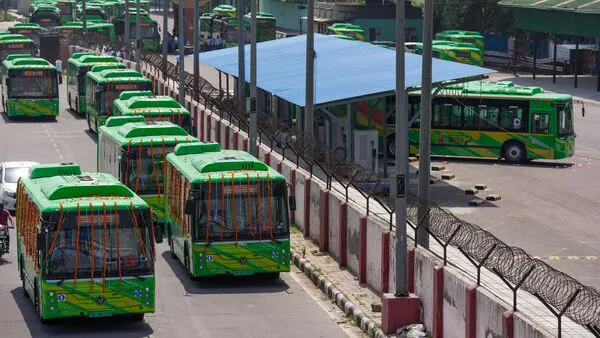
Govt Readies Fresh E-Bus Push For Mumbai, Pune, Hyderabad Under PM E-Drive
New Delhi: The ministry of heavy industries (MHI) is considering allocating 1,000 electric buses to Mumbai, 800 to Pune, and another 800 to Hyderabad in the second phase of the ₹10,900-crore PM E-Drive scheme, according to two people aware of the development.
Mint earlier reported that Maharashtra's two most populous cities – Mumbai and Pune – would be beneficiaries of the second phase of the scheme's tender, after Maharashtra fulfilled payment security conditions in September.
Now, the Centre is considering these allocations after the state government requested 1,500 e-buses for Mumbai and 1,000 for Pune under the scheme.
“The state government (of Maharashtra) had sought 1,500 e-buses for Mumbai and 1,000 for Pune earlier. But now, after evaluation, there is a consideration for 1,000 buses to Mumbai and 800 to Pune," said the first of the two persons cited above, both of whom spoke on the condition of anonymity.
Also Read | Easier EV financing for trucks, buses in the woEarlier, the Maharashtra government had not fulfilled the scheme's payment security demand, but now that it has done the needful, the next set of buses will go to Mumbai and Pune, said the second person.
Queries emailed to the heavy industries ministry and to state transport officials of Maharashtra and Telangana on 6 November remained unanswered.
Under the Centre's PM E-Drive scheme that was launched in 2024, the government aims to reduce the cost of procuring and operating 14,028 electric buses in nine cities with populations over 4 million – Delhi, Surat, Ahmedabad, Hyderabad, Bengaluru, Mumbai, Pune, Kolkata, and Chennai.
The second phase of PM E-Drive tenders will follow the first tender for 10,900 e-buses in five cities – Delhi, Bengaluru, Hyderabad, Ahmedabad, and Surat – that has been delayed by at least three months.
“Substituting diesel buses with electric ones will reduce vehicular emissions by a significant amount. Buses run continuously for long periods, compared to personal cars or 2Ws (two-wheelers), which only run for shorter periods in the day. So, with electric buses, you end up reducing a larger volume of emissions," said Ashim Sharma, senior partner and business unit head, Nomura Research Institute (NRI) Solutions and Consulting.
Also Read | India's largest e-bus tender deferred a third time as stringent terms s Deployment hurdlesKey challenges to deploying e-buses in states are inadequate charging infrastructure, especially in depots, as well as the high costs and stringent conditions for bus manufacturers to participate in these tenders, Mint reported earlier on 22 October.
“Putting these many e-buses on roads requires thorough planning. This includes planning for depots, chargers, and even designated lanes in some cases to make bus travel faster," said Sharma.
The PM E-Drive scheme is linked to the government's PM E-bus Sewa Payment Security Mechanism (PSM), under which states have to furnish a deposit with the Reserve Bank of India (RBI) to be eligible for sops for e-buses under the PM E-Drive scheme.
About 40% of the PM E-Drive scheme's outlay is allocated towards e-buses, to facilitate cleaner public transportation to reduce carbon emissions, and lower the country's fuel import dependence.
Mint earlier reported that e-bus makers have raised concerns about the asset-heavy model used in tendering the buses under the PM E-Drive scheme. The gross cost contract (GCC) model is used for this scheme.
Also Read | India's jumbo e-bus tender draws interest from half a dozen fiUnder this model, manufacturers retain ownership of the bus on their balance sheets, and state transport authorities pay them operating charges on a per-kilometer basis. The contract will be for a ten-year period. The Centre provides sops to state transport bodies, which in turn use them to pay bus makers.
Maharashtra has been a leading state in adoption of electric buses. E-bus sales in the state rose 48% to 665 units in the first six months of FY26, from 448 in the same period in FY25. The state's cricial highways, vital for passenger and freight movement, are among the routes the Centre has identified for electrification, including the Mumbai–Pune corridor.
Maharashtra was one of the top-performing states, alongside Delhi and Chandigarh, in the NITI Aayog's 2025 India Electric Mobility Index. The idex tracks the adoption of electric vehicles by states and cities.
E-bus sales in H1 FY26 (April-September) in India rose 37% year-on-year to 2,241 units. These buses are largely used for urban intra-city commutes, and on some routes between major cities (Delhi-Jaipur, Delhi-Agra, Delhi-Chandugarh, etc). Each year, approximately 3,000-3,500 such buses are sold, with each unit costing about ₹1-1.25 crore.
“India's potential for electric buses is significant, with only six e-buses per million people compared to the world average of 85. Currently, e-bus adoption is limited to a few states and cities, but widespread adoption is expected to drive exponential sales growth in the medium term," said ratings agency CareEdge ratings in a March 2025 report.
“If done well, the current plan would hold immense benefits for those who sit inside the bus as well for those who stand outside," Sharma of Nomura Research Institute said.
Legal Disclaimer:
MENAFN provides the
information “as is” without warranty of any kind. We do not accept
any responsibility or liability for the accuracy, content, images,
videos, licenses, completeness, legality, or reliability of the information
contained in this article. If you have any complaints or copyright
issues related to this article, kindly contact the provider above.

















Comments
No comment